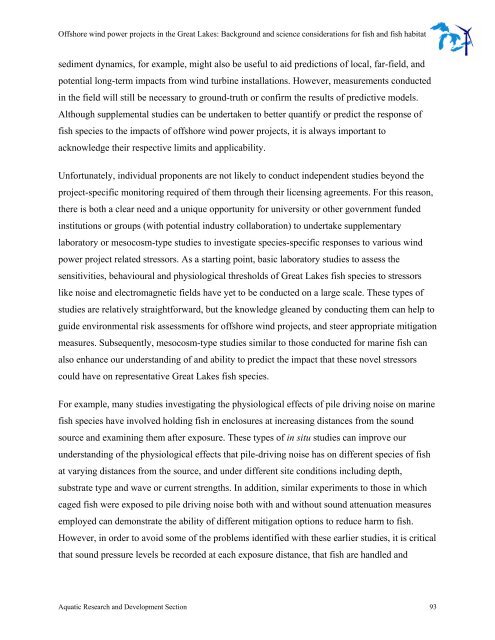Offshore Wind Power Projects in the Great Lakes - Ministry of ...
Offshore Wind Power Projects in the Great Lakes - Ministry of ...
Offshore Wind Power Projects in the Great Lakes - Ministry of ...
You also want an ePaper? Increase the reach of your titles
YUMPU automatically turns print PDFs into web optimized ePapers that Google loves.
<strong>Offshore</strong> w<strong>in</strong>d power projects <strong>in</strong> <strong>the</strong> <strong>Great</strong> <strong>Lakes</strong>: Background and science considerations for fish and fish habitat<br />
sediment dynamics, for example, might also be useful to aid predictions <strong>of</strong> local, far-field, and<br />
potential long-term impacts from w<strong>in</strong>d turb<strong>in</strong>e <strong>in</strong>stallations. However, measurements conducted<br />
<strong>in</strong> <strong>the</strong> field will still be necessary to ground-truth or confirm <strong>the</strong> results <strong>of</strong> predictive models.<br />
Although supplemental studies can be undertaken to better quantify or predict <strong>the</strong> response <strong>of</strong><br />
fish species to <strong>the</strong> impacts <strong>of</strong> <strong>of</strong>fshore w<strong>in</strong>d power projects, it is always important to<br />
acknowledge <strong>the</strong>ir respective limits and applicability.<br />
Unfortunately, <strong>in</strong>dividual proponents are not likely to conduct <strong>in</strong>dependent studies beyond <strong>the</strong><br />
project-specific monitor<strong>in</strong>g required <strong>of</strong> <strong>the</strong>m through <strong>the</strong>ir licens<strong>in</strong>g agreements. For this reason,<br />
<strong>the</strong>re is both a clear need and a unique opportunity for university or o<strong>the</strong>r government funded<br />
<strong>in</strong>stitutions or groups (with potential <strong>in</strong>dustry collaboration) to undertake supplementary<br />
laboratory or mesocosm-type studies to <strong>in</strong>vestigate species-specific responses to various w<strong>in</strong>d<br />
power project related stressors. As a start<strong>in</strong>g po<strong>in</strong>t, basic laboratory studies to assess <strong>the</strong><br />
sensitivities, behavioural and physiological thresholds <strong>of</strong> <strong>Great</strong> <strong>Lakes</strong> fish species to stressors<br />
like noise and electromagnetic fields have yet to be conducted on a large scale. These types <strong>of</strong><br />
studies are relatively straightforward, but <strong>the</strong> knowledge gleaned by conduct<strong>in</strong>g <strong>the</strong>m can help to<br />
guide environmental risk assessments for <strong>of</strong>fshore w<strong>in</strong>d projects, and steer appropriate mitigation<br />
measures. Subsequently, mesocosm-type studies similar to those conducted for mar<strong>in</strong>e fish can<br />
also enhance our understand<strong>in</strong>g <strong>of</strong> and ability to predict <strong>the</strong> impact that <strong>the</strong>se novel stressors<br />
could have on representative <strong>Great</strong> <strong>Lakes</strong> fish species.<br />
For example, many studies <strong>in</strong>vestigat<strong>in</strong>g <strong>the</strong> physiological effects <strong>of</strong> pile driv<strong>in</strong>g noise on mar<strong>in</strong>e<br />
fish species have <strong>in</strong>volved hold<strong>in</strong>g fish <strong>in</strong> enclosures at <strong>in</strong>creas<strong>in</strong>g distances from <strong>the</strong> sound<br />
source and exam<strong>in</strong><strong>in</strong>g <strong>the</strong>m after exposure. These types <strong>of</strong> <strong>in</strong> situ studies can improve our<br />
understand<strong>in</strong>g <strong>of</strong> <strong>the</strong> physiological effects that pile-driv<strong>in</strong>g noise has on different species <strong>of</strong> fish<br />
at vary<strong>in</strong>g distances from <strong>the</strong> source, and under different site conditions <strong>in</strong>clud<strong>in</strong>g depth,<br />
substrate type and wave or current strengths. In addition, similar experiments to those <strong>in</strong> which<br />
caged fish were exposed to pile driv<strong>in</strong>g noise both with and without sound attenuation measures<br />
employed can demonstrate <strong>the</strong> ability <strong>of</strong> different mitigation options to reduce harm to fish.<br />
However, <strong>in</strong> order to avoid some <strong>of</strong> <strong>the</strong> problems identified with <strong>the</strong>se earlier studies, it is critical<br />
that sound pressure levels be recorded at each exposure distance, that fish are handled and<br />
Aquatic Research and Development Section 93
















